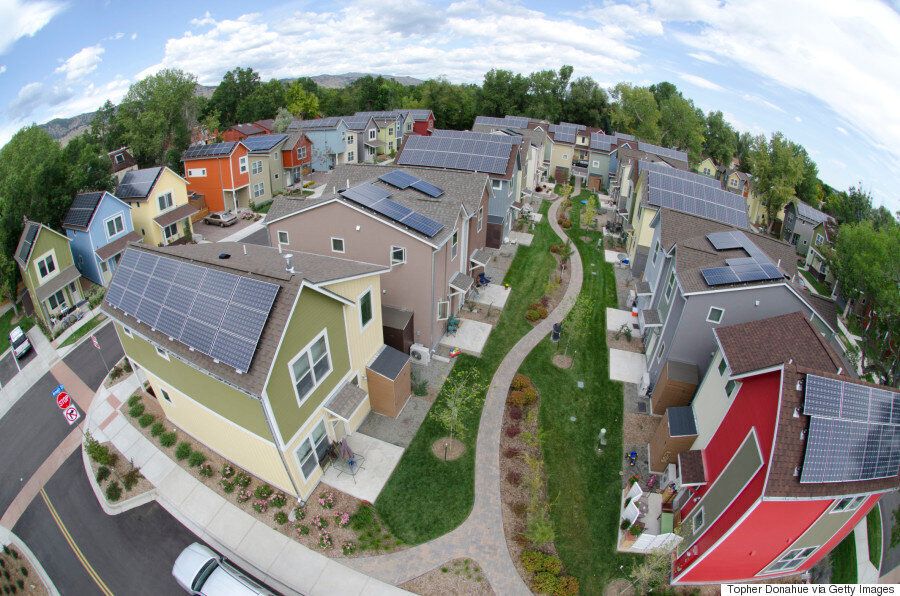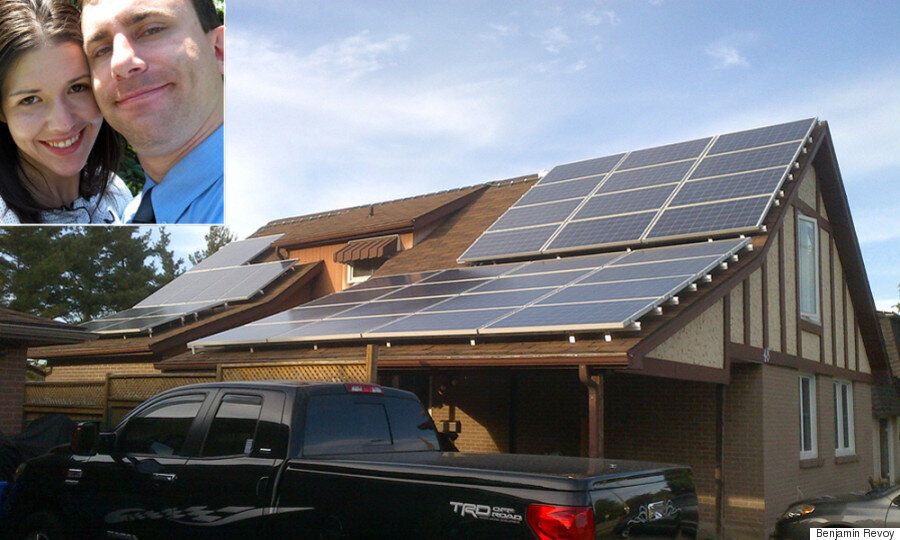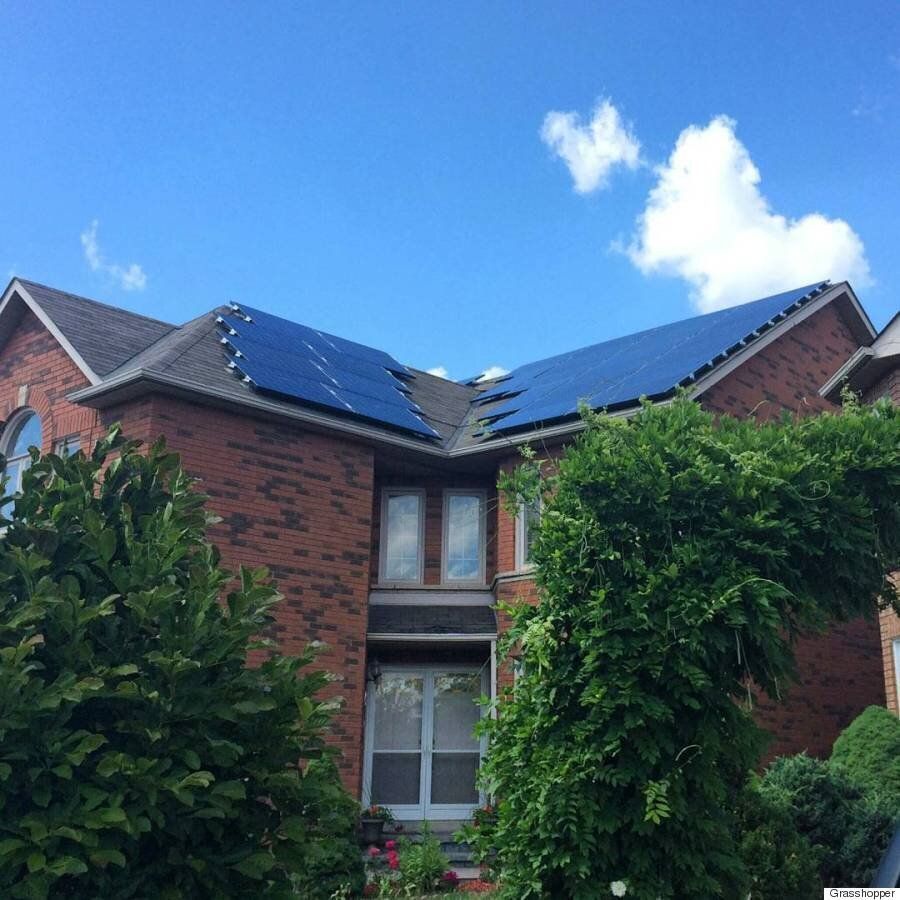
This campaign season, HuffPost Canada is going past the sales pitch, away from the attacks and beyond the ballot.
Our Beyond the Ballot series is deep diving into three major problems facing Canadians: climate change, housing insecurity, and elder care. This election is our opportunity to join forces and figure out how to solve them. In this installment we look at how individuals can generate their own energy.
Benjamin Revoy generates his own electricity. But he's no off-the-grid survivalist awaiting the End Times. The 34-year-old father of two from Kitchener, Ont., is selling his rooftop solar power back to the grid to help save the planet instead.
Welcome to our energy future, where we are consumers and generators of power.
"I want to leave the world better than I found it, and environmentalism is really core to that belief," Revoy told the Huffington Post Canada. So a few years ago, Revoy joined Ontario's MicroFIT program, an energy twist on the so-called sharing economy that has given rise to decentralized, anyone-can-do-it companies such as Uber or AirBnB. There are currently 20,300 participant with a combined generating capacity of over 160 megawatts. (One megawatt can power between 800 and 1000 homes.)
Emerging from the 2009 Green Energy Act – Ontario's big post-carbon climate change play – MicroFIT is a residential feed-in tariff (FIT) program. It allows homeowners to install small-scale renewable energy generation, mostly rooftop solar panels, and sell it back to the grid for a guaranteed subsidized rate over a 20 year contract. (There's also a FIT program for larger installations, such as farmers putting up windmills or small hydro on their land. There are currently over 3000 of these with a combined capacity of more than 4600 megawatts.)
"If it were today, I would've just gone out and bought a [solar panel] system and put it on my roof," Revoy said. "But three years ago, I was struggling to pay the bills and I couldn't do it. I didn't have the money." Undeterred by his lack of a down payment, he began researching financial solutions and discovered Grasshopper Solar.
The company, which employs about 300 staff and started out doing energy audits, pivoted to their "free solar program" after feed-in tariffs were introduced. They pay for everything up front, then make their money back with their cut of the earnings from power generation for the length of their contract.
"The environment gets the benefit and I get a very small cheque – but I still get a [$140] every month. I couldn't turn that down," said Revoy, who also put panels on a rental property he owns next door and has plans to install them on a supportive housing apartment he runs with his wife.

Grasshopper CEO Azeem Qureshi, who is also a delegate to the upcoming Paris climate change conference, is happy with Ontario's efforts on this front but remains concerned that the federal government isn't taking its UN-mandated carbon goals seriously.
The success of Ontario's program, as evidenced by the impressive number of people who have signed on and the power they've generated, need not be restricted to Ontario. Canada's electricity demands are only growing, coal plants in other provinces are still spewing out carbon and nuclear plants are aging fast.
The old way of energy generation may be large-scale but climate change is forcing us to look at new ways. One of those is adopting the sharing economy highlighted in companies such as Uber and AirBnb which show that decentralized drips can create mass.
By the same token, individuals can generate megawatts and their rooftop solar panels and backyard windmills can help Canada go green if given enough federal support.
Solar Power Sun Facts
- Ontario has 20,341 homes with rooftop solar panels
- The U.S. has 700,000 households with solar
- Germany produces over 50% of it electricity from solar
- Global solar power capacity is nearing 200 gigwatts, equal to 100 Hoover Dams. It is expected to double in 4 years.
"The government is reactive; it does not do things unless it's coming from the bottom," Qureshi said, pushing the importance of grassroots pressure. Energy is a provincial jurisdiction – which makes sense because each province has different energy mixes and needs – but Qureshi would like to see the feds working with the provinces to mandate and provide financial incentives for renewable programs to increase their percentage in that mix.
But, he admits, "you can come up with whatever fancy policy you want, but at the end of the day for a homeowner it has be black and white – are they making money or not. If they put in $100, what is the return on it? That's how people think."
Ontario is the only province offering an ongoing feed-in tariff program. Nova Scotia recently killed its own, ComFIT, apparently because it proved to be too popular. Nova Scotia's Liberal government said the program "has achieved its objectives" and to keep it running longer would increase electricity rates. The Sierra Club of Canada executive director John Bennet, however, blasted the decision as "disgrace" and told us it was done "to protect the interests of the monopoly power provider."
Paradoxically, the decline in oil prices and its impact on the oilsands may have the opposite effect in the West. Qureshi said "the solar industry believes the next large-scale adoption is most likely going to happen in Alberta" where they offer a FIT alternative called net metering.
MaRS clean technology advisor Tom Rand predicts that FIT programs will soon be a thing of the past — because that's what they're designed to do. The massive FIT programs in Germany and Spain have already caused the cost of solar generation to fall dramatically in recent years, and once solar reaches parity with other forms of power generation it won't require extra subsidies.
"The point about these kinds of policies that stimulate economic activity is that when the thing scales up, that policy can go away," he said. "The aerospace sector, the automotive sector, the nuclear sector, these all had training wheels on them when they got going. The Internet had training wheels. Microchips didn't come from someone's garage, they came from the military establishment, and that brought the cost down."
"Some point, coming very soon, you won't need it because net metering will be enough," Rand added. "That's the next phase."
More BEYOND THE BALLOT stories
- Leap Manifesto Calls On Canada To Change, Well, Everything
- Our Homes Are Hurting The Environment. Here's How The Next Government Could Fix It
- Make Climate Change Your Key Election Issue
- Canada Could End Homelessness. And It'll Only Cost You46 A Year
- 5 Things Our Next Government Should Do to Combat Climate Change
- The U.S. Can End Coal Power - Why Can't Canada?
Net metering is when people who generate their own power, have an electricity meter that measures both what comes into a house and what goes out. So if you generate more than you use, the excess is sold back to the grid at market rates. There is some controversy here, however. Some, like Toronto Hydro or Hydro-Québec, give credits only until your electricity bill reaches zero, while others do pay out, but at a much lower rate than a subsidized FIT program would.
But once net metering becomes standard, Rand said, "We will see some really explosive growth."
Net metering is also available in B.C., New Brunswick and Saskatchewan, and to a limited degree in Ontario, but Alexandra Campbell of IESO (Ontario's Independent Electricity System Operator) says it is "the next thing on the horizon" and is being actively discussed as a way to evolve the current residential renewables program.
"The trick is making it easy for people to do the right thing," she said.
That's the rub, and also what makes seemingly boring terms like feed-in tariff, net metering and distributed microgrid systems so exciting. It involves regular people: city slickers, suburban families, rural farmers. Anyone.
Think about how abstract the problem of garbage was until you were forced to actually separate your recyclables and organics. Well, introducing these residential programs on a national scale will literally bring the issue of energy and climate change home.

"It would have massive impact," said Melina Laboucan-Massimo, a Greenpeace energy and climate campaigner whose Lubicon Cree First Nation in northern Alberta has just installed its own solar power system. "The fossil fuel regime makes us think that we're dependent, but what happens with decentralized power is that it becomes more of an energy democracy. It empowers people. Every roof and every family can be a part of the solar solution."
Even though rooftop solar power makes sense for about one-third of homes, depending on sun access, trees, etc. we're still talking millions of potential Canadians producing their own renewable power and pushing the country into a clean energy future.
"It's important for everyone to feel and be involved," Revoy said. "We have to be active participants in our success or we will be active participants in our failure."
Joshua Ostroff is senior editor for HuffPost Canada.

Some issues go beyond talking points. Tell us what they are on Twitter or Facebook with the hashtag #BeyondTheBallot.